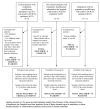Th1 and Th17 hypercytokinemia as early host response signature in severe pandemic influenza
- PMID: 20003352
- PMCID: PMC2811892
- DOI: 10.1186/cc8208
Th1 and Th17 hypercytokinemia as early host response signature in severe pandemic influenza
Abstract
Introduction: Human host immune response following infection with the new variant of A/H1N1 pandemic influenza virus (nvH1N1) is poorly understood. We utilize here systemic cytokine and antibody levels in evaluating differences in early immune response in both mild and severe patients infected with nvH1N1.
Methods: We profiled 29 cytokines and chemokines and evaluated the haemagglutination inhibition activity as quantitative and qualitative measurements of host immune responses in serum obtained during the first five days after symptoms onset, in two cohorts of nvH1N1 infected patients. Severe patients required hospitalization (n = 20), due to respiratory insufficiency (10 of them were admitted to the intensive care unit), while mild patients had exclusively flu-like symptoms (n = 15). A group of healthy donors was included as control (n = 15). Differences in levels of mediators between groups were assessed by using the non parametric U-Mann Whitney test. Association between variables was determined by calculating the Spearman correlation coefficient. Viral load was performed in serum by using real-time PCR targeting the neuraminidase gene.
Results: Increased levels of innate-immunity mediators (IP-10, MCP-1, MIP-1beta), and the absence of anti-nvH1N1 antibodies, characterized the early response to nvH1N1 infection in both hospitalized and mild patients. High systemic levels of type-II interferon (IFN-gamma) and also of a group of mediators involved in the development of T-helper 17 (IL-8, IL-9, IL-17, IL-6) and T-helper 1 (TNF-alpha, IL-15, IL-12p70) responses were exclusively found in hospitalized patients. IL-15, IL-12p70, IL-6 constituted a hallmark of critical illness in our study. A significant inverse association was found between IL-6, IL-8 and PaO2 in critical patients.
Conclusions: While infection with the nvH1N1 induces a typical innate response in both mild and severe patients, severe disease with respiratory involvement is characterized by early secretion of Th17 and Th1 cytokines usually associated with cell mediated immunity but also commonly linked to the pathogenesis of autoimmune/inflammatory diseases. The exact role of Th1 and Th17 mediators in the evolution of nvH1N1 mild and severe disease merits further investigation as to the detrimental or beneficial role these cytokines play in severe illness.
Figures





Comment in
-
First evidence of a pro-inflammatory response to severe infection with influenza virus H1N1.Crit Care. 2010;14(1):115. doi: 10.1186/cc8846. Epub 2010 Feb 11. Crit Care. 2010. PMID: 20236480 Free PMC article.
-
Th17 mediators and vitamin D status.Crit Care. 2010;14(2):410. doi: 10.1186/cc8894. Epub 2010 Mar 31. Crit Care. 2010. PMID: 20377919 Free PMC article.
-
Cytokine profiles of suction pulmonary secretions from children infected with pandemic influenza A(H1N1) 2009.Crit Care. 2010;14(2):411. doi: 10.1186/cc8918. Epub 2010 Apr 13. Crit Care. 2010. PMID: 20416119 Free PMC article.
-
Th17 mediators and vitamin D status in influenza A (H1N1).Crit Care. 2010;14(3):417. doi: 10.1186/cc8995. Epub 2010 May 17. Crit Care. 2010. PMID: 20497610 Free PMC article. No abstract available.
References
Publication types
MeSH terms
Substances
Grants and funding
LinkOut - more resources
Full Text Sources
Other Literature Sources
Medical
Miscellaneous

